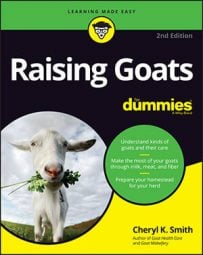Before you turn your goat fiber into yarn, you need to put it through several processes. To process your fiber, you need to wash, card or comb, and spin. Here are some hints for preparing goat fiber.
Washing
Unless you're selling your raw fleece to a commercial operation, you need to wash your goat fleece to remove grease, dirt, and other impurities:
Separate the fleece into smaller bundles and put them into mesh bags.
Do not pack the fleece tightly into the bags.
Put 145°F water in your sink. Wearing rubber gloves, check the water's pH.
If it is below 8, thoroughly mix in small amounts of baking soda until the pH is 8 or 9. (Neutral pH is 7.) Then mix in a small amount of detergent.
Place your bags of fleece in the water and soak for 15 minutes.
Pull out a bag and check a lock of fleece. If it is gummy, all of the grease is not out and you need to keep soaking it for up to another 45 minutes.
Refill the sink with 145°F water, using only half the detergent and no baking soda. Soak for 15 more minutes.
Remove the fleece from the water and let out the water. Fill the sink with more hot water and soak the fleece for 15 to 30 minutes, agitating it with your hand from time to time.
Remove the bags, refill the sink, and rinse for 15 to 30 minutes, using cooler water each time.
Rinse a final time.
Check the pH of the final rinse; it should be 6. If it is higher, add a small amount of vinegar to lower the pH. Soak and rinse for 15 minutes.
Dry the clean fleece.
Remove the bags, press them gently, and then remove the fleece from the bags. Spread out the fleece to dry on a towel as you would a wool sweater. You can use a fan to accelerate drying.
Carding or combing
Carding and combing are ways to separate the strands of washed fiber to prepare it for spinning into yarn. Both methods blend the fibers and remove hay and other contaminants that may still be left in the fiber. They also straighten the fibers to make them lie in the same direction. Carding produces a fluffier end product than combing because combing better aligns the fibers and makes the fleece more compact.
You can card your fiber by hand or with a carding machine. To comb your fiber, you can use paddle combs. These are similar to hand carders, but they are simpler and have only one or two rows of teeth. They are good for working medium to long fibers or for working with cashmere, where you have to remove the guard hairs as you go along. Combing separates the long and short fibers and prepares the fiber for spinning.
Spinning
Handspinning is the traditional method and requires a drop spindle or a spinning wheel.
You need to practice spinning the drop spindle without yarn to get used to working with it. To spin with a drop spindle, you attach a piece of yarn (called a leader cord) to your spindle and then attach the end of your fiber to that. You have to spin in the same direction (normally clockwise) to hold your fiber together. As you spin the wheel, you gradually add fiber to the end of the rolag or roving you are working with.
Spinning on a wheel requires you to use your hands and feet. You use your feet by pushing on a treadle that keeps the wheel moving as you gradually add fiber to be spun into yarn. You need to practice to learn to move your hands and feet together and get a consistent product. After you get it, the process seems like second nature, and spinners even say it's incredibly relaxing.

